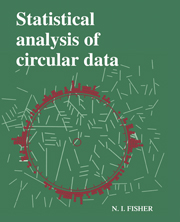Book contents
- Frontmatter
- Contents
- Preface to the first paperback edition
- Preface
- 1 Introduction
- 2 Descriptive methods
- 3 Models
- 4 Analysis of a single sample of data
- 5 Analysis of two or more samples, and of other experimental layouts
- 6 Correlation and regression
- 7 Analysis of data with temporal or spatial structure
- 8 Some modern statistical techniques for testing and estimation
- Appendix A Tables
- Appendix B Data sets
- References
- Index
4 - Analysis of a single sample of data
Published online by Cambridge University Press: 03 May 2011
- Frontmatter
- Contents
- Preface to the first paperback edition
- Preface
- 1 Introduction
- 2 Descriptive methods
- 3 Models
- 4 Analysis of a single sample of data
- 5 Analysis of two or more samples, and of other experimental layouts
- 6 Correlation and regression
- 7 Analysis of data with temporal or spatial structure
- 8 Some modern statistical techniques for testing and estimation
- Appendix A Tables
- Appendix B Data sets
- References
- Index
Summary
Introduction
The methods in this chapter are concerned with the analysis of a sample of independent observations θ1,…, θn from some common population of vectors or axes. A number of data sets were introduced in Chapter 2, in the context of methods for displaying data. Here, we begin with some other examples to illustrate the range of problems which occur with a single sample of data.
Example 4.1 Figure 4.1 shows a plot of the directional preferences of 50 starhead top-minnows, after they had been displaced to unfamiliar surroundings and then subjected to heavily overcast conditions. (The data are listed in Appendix B4.) The fish use a sun compass to move in a direction which, at the location of their capture, would return them to the land–water interface. It is of interest to know whether they still have a preferred orientation, or whether the distribution is essentially uniform on (0°, 360°).
Example 4.2 Figure 4.2 shows a plot of measurements of long-axis orientation of 60 feldspar laths in basalt. (Both ends of each axis are plotted. The data are listed in Appendix B5.) In this example, it is of interest to know whether the distribution is essentially uniform, or whether there are, in fact, several modal groups present.
Example 4.3 Figure 4.3 shows a plot of 30 cross-bed azimuths of palaeocurrents measured in the Belford Anticline in New South Wales. […]
Information
- Type
- Chapter
- Information
- Statistical Analysis of Circular Data , pp. 59 - 104Publisher: Cambridge University PressPrint publication year: 1993
Accessibility standard: Unknown
Why this information is here
This section outlines the accessibility features of this content - including support for screen readers, full keyboard navigation and high-contrast display options. This may not be relevant for you.Accessibility Information
- 1
- Cited by
